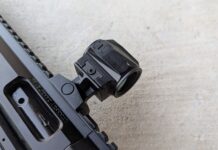If you are curious about barrel twist rates and what they mean in the grand scheme of what you look for your firearm to be able to accomplish, hit play and let 9-Hole take it away.
If you don’t have 10 minutes right now, come back to the video later and read on below.
Rifling
For those newer in the space, rifling is the swirling cuts you see in the steel as you look down the barrel. The terminology gets as deep as anything else in the firearm sphere but for our sake here we will keep it incredibly simple.
Rifling is there to spin the bullet so that it stabilizes in flight, think of a proper spin on a thrown football.
Rifling does this by interacting with the bullet jacket, the outer surface of the bullet is a little thicker than the inner diameter of the barrel. When pressure from the powder pushes the bullet down the barrel the rifling starts it spinning.
The spinning results in greater stability once it leaves the barrel and therefore greater accuracy.
Rifle Twist Rate
In the US you will usually see the twist rate posted as 1:7 or 1:10. Variations exist like 1 in 7 and 1/7 but they all in denote that the rifling completes one full revolution in the span of 7, 10, 12 inches. In most other nations they will use millimeters for twist and barrel length both. So a 16 inch, 1:7 twist barrel would be a 406mm, 1 in 177mm twist barrel.
Twist Rate to Bullet Weight
Bullets have a fixed diameter, they will be exactly as wide as needed to go down the barrel. The bullet will also have an ideal weight, based on the length and shape. That weight is what will work ideally with the rifle twist to stabilize the bullet during flight.
The rule of thumb is the heavier, and therefore longer, the bullet the faster/shorter the twist rate should generally be. That is an oversimplification but it isn’t an egregious one.
So heavier 5.56/.223 should use 1:7 or 1:8 instead of 1:9 or 1:12 and heavier .308 benefits from 1:10 while lighter can use 1:12. These are again generalizations and real world performance is real world performance.



